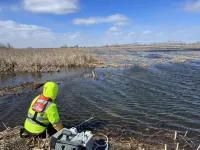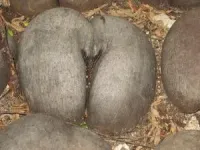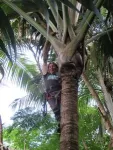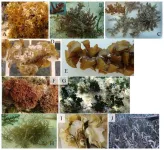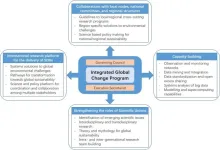(Press-News.org) Recently, morning omelets and holiday dinners have gotten more expensive. One likely cause is bird flu, outbreaks of which led to the deaths of millions of chickens and turkeys from infection or culling in 2022, according to the U.S. Department of Agriculture, and which still demands rigorous monitoring of wild populations. Now, reporting in Environmental Science & Technology Letters, researchers have developed a method that detected infectious bird flu virus in wetlands frequented by waterfowl.
Wild birds represent a significant reservoir of avian influenza virus. While some viral strains don’t cause disease, the highly pathogenic avian influenza (HPAI) form can spread quickly and is often fatal. It spreads from wild birds that shed the pathogen through their feces into the environment, including the wetlands they inhabit. Detecting bird flu in these waters has proven challenging because infectious virus concentrations are often too low to be detected by most methods, leaving a significant gap in our understanding of viral transmission. To address this problem, Laura Hubbard at the U.S. Geological Survey and colleagues devised a multistep process to concentrate and identify infectious virus in environmental samples.
They tested their protocols on surface water samples taken twice in the spring of 2022 from four wetlands and a lake in Iowa. The team identified strains of infectious virus in samples from all four wetland sites in April, but not from the lake. Detection rates were significantly lower, however, when they tested the water samples for viral RNA (11.1%) using standard diagnostic protocols than when the same samples were inoculated into eggs and avian influenza virus was isolated and confirmed (66.7%). The researchers say these results highlight the need for improved RNA detection techniques to reduce the risk of false negatives.
Sequencing showed that most of the detected viral strains present in the water samples had low pathogenicity. One sample included HPAI, however, marking the first time this strain has been detected in a U.S. waterway, the researchers say. Just five weeks later, though, they did not detect avian influenza virus in any samples from the same sites despite previous research that demonstrated viral persistence for months in similar environments. The researchers suggest that the apparent absence of virus could be due to many environmental factors, including fewer waterfowl being present in May and substantially warmer water temperatures influencing virus survival.
Although further research is required to better understand the persistence and potential transmissibility of bird flu in wetlands, the researchers say the detection of HPAI virus and other strains highlights possible risks to wild and domestic fowl, other animals and even humans, who use these waterways recreationally. They also suggest that regular monitoring and early detection could help mitigate costly viral transmission and the rising cost of eggs and poultry.
The authors acknowledge funding from the U.S. Geological Survey through the Biological Threats and Environmental Health Programs of the Ecosystems Mission Area and from the Centers for Disease Control and Prevention, Influenza Division.
The paper’s abstract will be available on Nov. 15 at 8 a.m. Eastern time here: http://pubs.acs.org/doi/abs/10.1021/acs.estlett.3c00668
The American Chemical Society (ACS) is a nonprofit organization chartered by the U.S. Congress. ACS’ mission is to advance the broader chemistry enterprise and its practitioners for the benefit of Earth and all its people. The Society is a global leader in promoting excellence in science education and providing access to chemistry-related information and research through its multiple research solutions, peer-reviewed journals, scientific conferences, eBooks and weekly news periodical Chemical & Engineering News. ACS journals are among the most cited, most trusted and most read within the scientific literature; however, ACS itself does not conduct chemical research. As a leader in scientific information solutions, its CAS division partners with global innovators to accelerate breakthroughs by curating, connecting and analyzing the world’s scientific knowledge. ACS’ main offices are in Washington, D.C., and Columbus, Ohio.
To automatically receive news releases from the American Chemical Society, contact newsroom@acs.org.
Follow us: Twitter | Facebook | LinkedIn | Instagram
END
Surveilling wetlands for infectious bird flu — and finding it
2023-11-15
ELSE PRESS RELEASES FROM THIS DATE:
Not so silver lining: Microplastics found in clouds could affect the weather
2023-11-15
From the depths of the seas to snow on mountains and even the air above cities, microplastics are turning up increasingly often. Now, in ACS’ Environmental Science & Technology Letters, researchers have analyzed microplastics in clouds above mountains. They suggest that these tiny particles could play a role in cloud formation and, in turn, affect weather.
Microplastics — plastic fragments smaller than five millimeters — originate from a myriad of items used daily, such as clothing, packaging and car tires. As research in the field evolves, scientists are not only detecting microplastics in the atmosphere but also investigating how they may play a role in cloud formation. ...
Association of molecular subtypes in bladder cancer with response to neoadjuvant chemotherapy, progression, and survival
2023-11-15
Considering the molecular subtype of muscle-invasive bladder cancer (MIBC) based on differences in tumor RNA expression can improve the ability of an existing tumor biomarker such as the COXEN score to predict which patients’ tumors are likely to respond to chemotherapy given before surgery. Individual molecular subtypes, however, were not associated with significant differences in patients’ overall survival (OS) or progression-free survival (PFS) times.
Those are the conclusions from a secondary analysis of data from the S1314 clinical trial, a large study in patients with MIBC that was conducted by the SWOG Cancer Research Network, a clinical trials group funded by ...
Colliding ribosomes activate RNA repair
2023-11-15
Aldehydes are toxic compounds that are produced in the body by metabolic processes, especially upon alcohol consumption. They are dangerous because they bind to cellular macromolecules such as DNA, RNA, and proteins, and crosslink them.
Crosslinking damage to DNA must be repaired by the cell to prevent premature aging and cancer. However, it was previously unknown whether and how cells sense and resolve crosslinking damage to single-stranded RNA. A team led by Professor Julian Stingele from ...
On two small islands in the Indian Ocean, an endangered palm with the world’s largest seed sows a lesson about landscape restoration
2023-11-15
Every tree species has its story. Unraveling all 73,000 of them is a significant undertaking for science, in no small part because a considerable proportion of tree biodiversity is tropical, rare, remote and subject to the ravages of deforestation. And an estimated 9,200 tree species have yet to be discovered.
Even trees well-known to science have mysteries. One is the Seychelles’ endangered coco de mer, or sea coconut palm tree, which is now relegated to parts of two small Indian Ocean islands and in decline. Only some 8,200 individuals remain.
What Lodoicea madivica lacks in range it makes ...
New scientific study reveals the crucial role of herbivorous fishes and sea urchins in restoring Caribbean coral reefs
2023-11-15
A new study by Dr. Lindsay Spiers (Florida Fish and Wildlife Conservation Commission) and Professor Thomas Frazer (College of Marine Science at the University of South Florida), published in PeerJ Life & Environment, presents crucial findings on the feeding preferences of herbivorous fishes and the sea urchin Diadema antillarum in Little Cayman. The study, titled "Comparison of feeding preferences of herbivorous fishes and the sea urchin Diadema antillarum in Little Cayman," sheds new light on the dynamics of these herbivores and their impact on the resilience of Caribbean coral reefs.
Caribbean coral reefs face significant challenges, ...
The Future of Future Earth: How global science programs can navigate the complex, shifting challenges in sustainability science
2023-11-15
The global change program Future Earth is an international alliance of organizations and agencies that was launched by the UN in June 2012. The Future Earth 2025 Vision identified eight global challenges for scientific research to accelerate progress in sustainability, improve collaboration, and mobilize resources.
After more than a decade of this global change program, researchers are analyzing the challenges Future Earth has faced and the path forward. Discussion presented in a recently published paper reviews these challenges faced by the coalition and proposes solutions to help these programs meet the many needs of the global community.
The paper was published on ...
Georgetown Global Health Center launches first open-access wildlife disease database
2023-11-15
WASHINGTON (November 15, 2023) – Georgetown University Medical Center’s Center for Global Health Science and Security (GHSS) today announces the launch of a first-of-its-kind wildlife disease database -- a system for collecting records of viruses, bacteria, fungi, parasites, etc. -- designed to support an early warning system for potential viral emergence. The Pathogen Harmonized Observatory, or PHAROS, is open to the global community and free to access.
Scientists in GHSS’ Verena program, a collaborative ...
University of Basel delivers first biological implants for treatment of cartilage lesions and osteoarthritis in humans
2023-11-15
The Department of Biomedicine at the University of Basel and the University Hospital Basel, today announced that it delivered the first surgical procedure to treat Osteoarthritis (OA) in humans. The procedure called Nasal Chondrocyte Tissue-Engineered Cartilage, or N-TEC, provides an innovative alternative to cure confined knee cartilage lesions as well as to address degenerative OA cases that have to date required knee joint replacements – prosthetics that routinely need replacing after 15-20 years.
The team at Basel is spearheading the next-generation human clinical trials that will ...
From 2018 to 2022, eating disorder claim lines increased 65 percent nationally as a percentage of all medical claim lines
2023-11-15
NEW YORK, NY—November 15, 2023—From 2018 to 2022, eating disorder claim lines increased 65 percent nationally as a percentage of all medical claim lines.[1] All eating disorders studied increased during this period, but at different rates: avoidant/restrictive food intake disorder (ARFID) by 305 percent,[2] binge-eating disorder by 81 percent, anorexia nervosa (anorexia) by 73 percent and bulimia nervosa (bulimia) by 3 percent. These and other findings on eating disorders are reported in a FAIR Health white paper released today: Spotlight on Eating Disorders: An Analysis of Private Healthcare Claims.
Eating ...
NTU Singapore’s strength in research excellence sees it ranked 22nd globally and first in Singapore with most number of highly cited researchers
2023-11-15
Nanyang Technological University, Singapore (NTU Singapore) is up one spot to 22nd globally in this year’s Highly Cited Researchers list by Clarivate, a United Kingdom-based data company.
For the sixth year running, the University has the largest number of influential scientists among Singapore institutions recognised, with 42 NTU researchers that have significant and broad influence in their fields of research named.
These 42 scientists account for 44 mentions in the list, with two individuals recognised more ...
